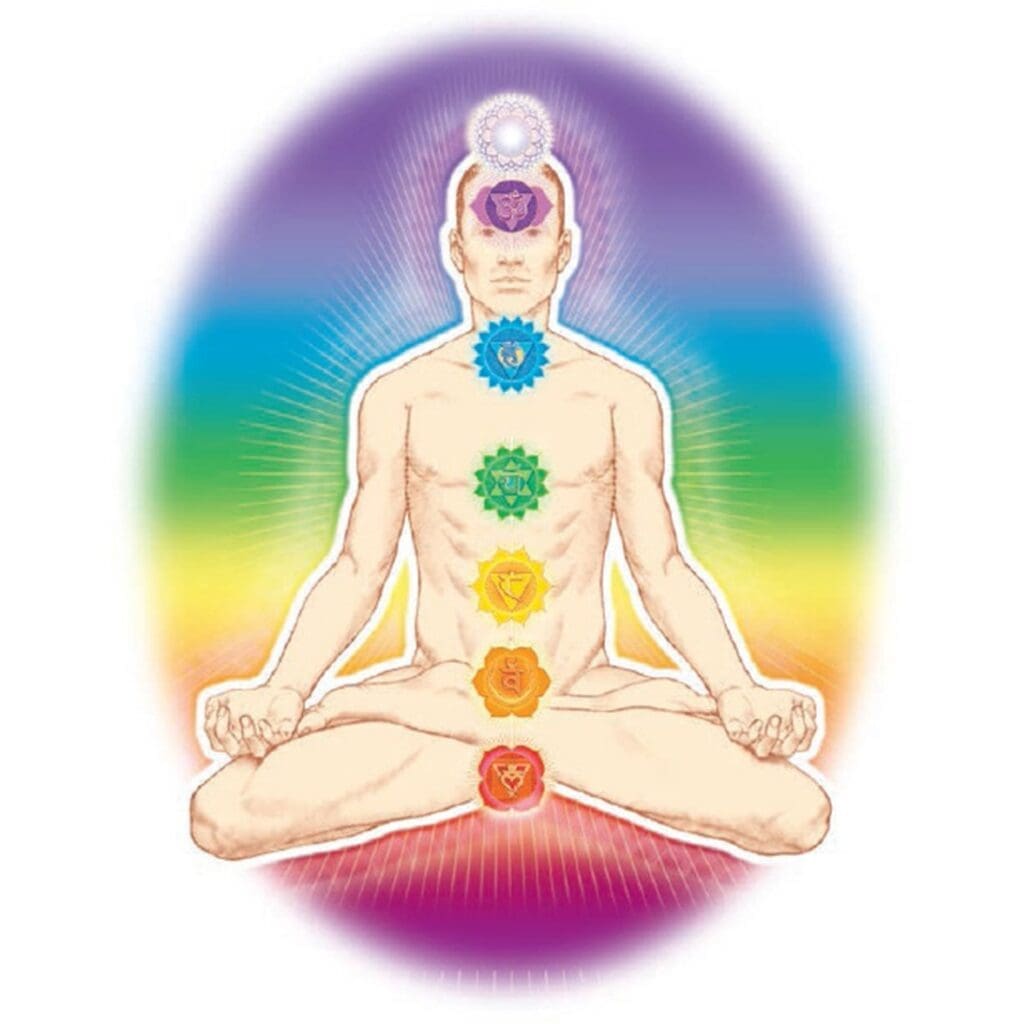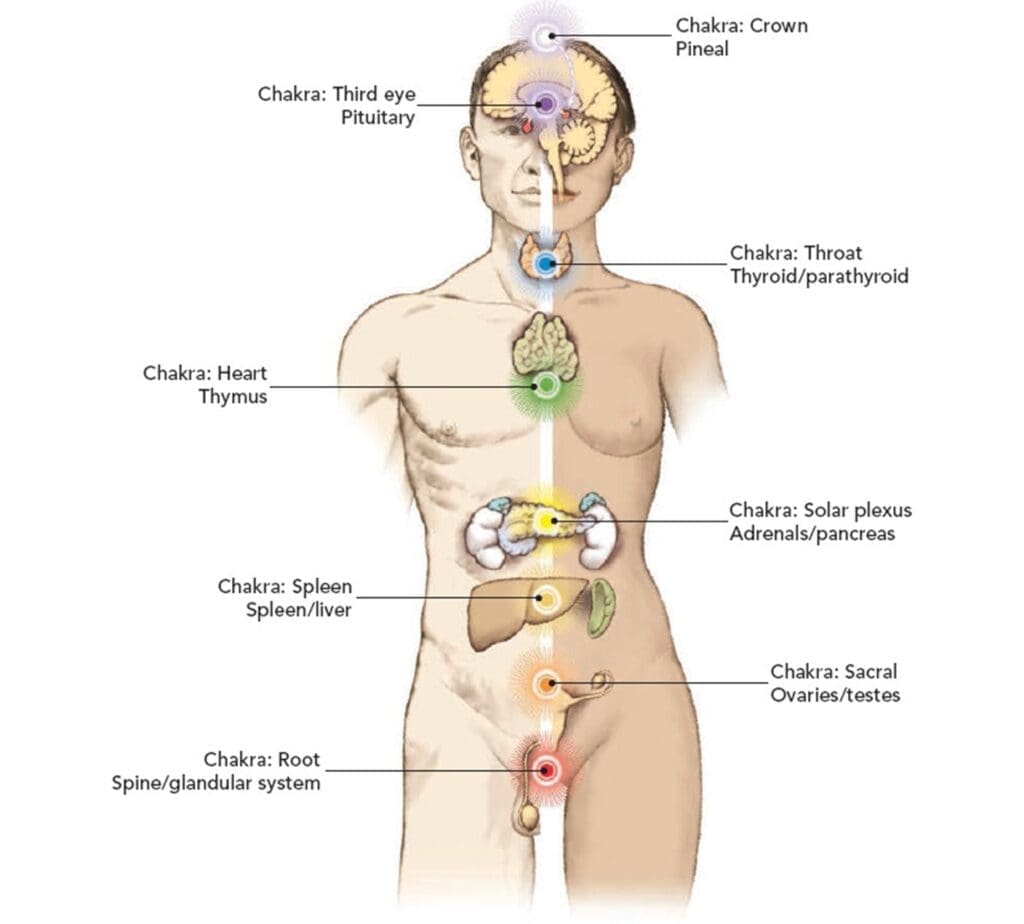Each chakra influences the body in unique physical, emotional, mental, and spiritual ways. This is because each energy organ vibrates at its own frequency and spins at its own particular velocity.
Remember the definition of energy we have been working with: information that moves. Therefore, information has speed and frequency. Varying speeds and frequencies change the information in each tiny piece of energy.
Information with a speed faster than light is received as subtle energy, and can be interpreted via the chakra. Information that moves at the speed of light or slower is received by the chakra as sensory, and will impact physical reality. A chakra can accept and transform both types of energy, turning them back into information useful to the individual.
A chakra vibrates from inside the physical body to the outside, radiating the information through the skin. It also pulls information from outside into the body, transforming it for reception. Even out-of-body chakras connect into the physical body. This in-and-out streaming of energy means that the chakras actually look more like bands of nonending energy, rather than the conical vortices they are often depicted as.
Not only does chakra energy flow like a never-ending river, this energy flow attracts other energies in the universe. Some of these interact to form a mini-universe of the self, including the auric field—layers of energy that surround the human body—and other energy channels, bodies, and fields that flow within and outside the self (these include the nadis as well as secondary energy bodies, such as the causal and emotional bodies).
Each chakra vibrates at a different frequency. The lower in the body it is, the slower the vibration; the higher in the body, the faster the vibration. People who are attuned to these frequencies see them as light and color. The in-body chakras occupy visible light, with the lowest touching into the infrared portion of the color spectrum and the higher body chakras, the ultraviolet portion.
The lower a chakra is within, or in relation to, the body, the closer it is to the infrared spectrum of light. The higher the chakra is within, or in relation to, the body, the more it stretches into the ultraviolet frequencies of light. Red is the first visible color we see after we pass the infrared and nonvisible band of light. It is associated with the first chakra, in the groin. Violet is the last color that we can see before we shift into ultraviolet frequencies, and is the color we associate with the sixth chakra in the forehead.
This illustration of the chakra color spectrum (figure 5.3) poses questions about the visibility of the chakras. One of the foremost questions is this: If the chakras are there, and vibrating in these color frequencies, why are we unable to perceive the colors with our physical eyes? Our brain waves usually oscillate between 0 and 100 cycles per second (or Hz). (See Valerie Hunt’s study in “Scientific Research” below.) Chakras vibrate in a band between 100 and 1,600 Hz. This means that our brains are simply not trained to perceive oscillations or frequencies as high as those that the chakras regulate.
Intuitive people through the ages, however, have recurrently discerned six, if not seven, chakras. The primary six (the first through sixth chakras) have frequencies associated with the physically visible spectrum (red, orange, yellow, green, blue, and violet). Intuition often discerns only that which the brain allows it to discern. If the brain says, “I cannot see infrared or ultraviolet,” our intuition will not distinguish colors—or chakras—in the lower or higher spectrums. This might account for the reason that so many esoteric practitioners locate the seventh chakra, which has the frequency of white light, above, rather than within, the human body. It is “otherworldly,” or outside of the norm. It might also explain why some psychic individuals identify chakras lower and higher than the body. They might simply be able to distinguish “shades of gray” that others do not know how to look for.
FIGURE 5.2
CHAKRAS AS WAVES
Chakras have traditionally been described as “wheels of light”: vortices of spinning energy that emanate from the spine. From a psychic’s point of view, they are more often seen as bands of loosely interconnecting waves that carry information into and out of the body.

Considerable research is validating the existence of the chakras, with Dr. Valerie Hunt serving as a pioneer. For the past twenty years, Hunt, a professor of kinesiology (the study of human movement) at the University of California in Los Angeles, has measured human electromagnetic output under different conditions. Using an electromyograph, an instrument that measures the electrical activity of the muscles, Hunt discovered that the physical body emanated radiation at sites typically associated with the chakras. In addition, she discovered that certain levels of consciousness were linked to specific frequencies.16
When people in her studies were thinking of daily situations, their energy fields measured frequencies in the range of 250 Hz. This is the same frequency as the heart. When psychic individuals had their energy fields tested on the electromyograph, their frequency ranged in a band from 400 to 800 Hz. Trance specialists and channelers fell into the 800 to 900 Hz range, and mystics, connected continually to their higher self, had a energy field, or etheric body, above 900 Hz.
Hunt’s findings correlate with traditional chakra lore: the chakras can be stepping-stones to enlightenment, each inviting a different spiritual awareness and increasing the frequency of the subtle body. In fact, the manufacturer of the equipment adapted the machine to measure higher frequencies, and it was found that a mystic had an average subtle energy field frequency of 200,000 Hz.17
FIGURE 5.3
CHAKRAS ON THE ELECTROMAGNETIC SPECTRUM

Hunt also found changes in coloration emanating from the chakra points when subjects were being rolfed, as she discusses in an abstract cowritten by Dr. Wayne Massey and others.18 Rolfing is a form of massage that achieves structural integration by means of manipulating the myofascia. While a subject was being rolfed, measurement was conducted with Fourier analysis and a sonogram frequency analysis. As subjects were monitored with equipment, noted healer Reverend Rosalyn Bruyere recorded the colors she saw through psychic vision.
The registered frequencies were measurable by color but also sound. Both Bruyere’s psychic vision and the frequency recording equipment reported the same changes in coloration, chakra to chakra. The colors were observed to be the same as in metaphysical literature: root, or first chakra, was red; “hypogastric,” or second chakra, was orange; spleen, or third, was yellow; heart, or fourth, was green; the throat, or fifth, was blue; the third eye, or sixth chakra, was violet; and the crown, or seventh chakra, white.
FIGURE 5.4
CHAKRAS AND THE ENDOCRINE SYSTEM

One of Hunt’s concepts is that, from a quantum perspective, the body is more than a conglomerate of systems (such as endocrine, neuromuscular, or cardiovascular). Instead, all systems and tissues are organized by energy: specifically, bioenergy. The study suggests the existence of the chakras and recognizes them as involved with the physical, emotional, and energetic natures of our being.
Yet another study, conducted on an extremely clairvoyant individual, Dora van Gelder Kunz, suggests the existence of the chakras. Mrs. Kunz was asked to observe two hundred people with various diseases and to describe their illnesses in terms of alterations in the nonphysical bodies and the chakras.19 Dr. Shafica Karagulla, researcher and author of the book The Chakras and Human Energy Fields, compared Mrs. Kunz’s reports with standard medical diagnosis. Researchers in this study discovered that diseases do alter the behavior of chakras and nonphysical bodies in terms of color, luminosity, rhythm, rate, size, form, elasticity, and texture.
One exciting outcome of this research was a detailed correlation between the chakras and the endocrine glands. The researchers discovered that a problem with a particular gland would show up in the chakra. If the pineal gland was disturbed, for example, the crown chakra would be as well. The correlation found between chakras and endocrine glands is as shown in figure 5.4.
As is apparent from this illustration, the researchers found eight main chakras (adding the spleen), rather than the more traditional seven chakras. They also noticed the existence of minor chakras in the palms of the hands and the soles of the feet.
Dr. Hiroshi Motoyama, a scientist and a Shinto priest, also investigated the science of the chakras. He has conducted numerous studies to verify the energy system, many of which have become the basis of his more than twenty books. Dr. Motoyama has created a device to detect minute electrical, magnetic, and optical changes in the vicinity of a subject. It is called the apparatus for measuring the functioning of the meridians and corresponding internal organs, or AMI. During one test, Motoyama found that increased activity of the heart chakra area actually produced a weak but measurable physical light. Subjects were asked to press a button whenever they thought they were experiencing psi-energy, or psychic sensations such as inexplicable feelings, pictures, or sounds. These internal feelings correlated to objectively measured periods of heart activity. Experiments similar to this one led Motoyama to conclude that mental concentration on a chakra is the key to activating it.20
These and other studies led Dr. Motoyama to deduce that certain individuals can project their energy through the chakras, a statement supported by Itzhak Bentov, a researcher of physiological changes associated with meditation. Bentov has duplicated Motoyama’s findings regarding electrostatic energy emission from the chakras.21
Dr. Motoyama suggests that the chakras are represented in the central nervous system by the brain and nerve plexuses, as well as in the meridian acupuncture points. Though chakras are separate from the central nervous system and the meridians, Motoyama considers the chakras as superimposed upon these other two systems, rather than occupying the same physical space.22
As Dr. Motoyama explains, the chakras supply the physical body with outside energy through the nadi system, a circuitry that spreads subtle energy throughout the body. Motoyama states that the “gross nadi” equate with the meridian system, and together they represent a “physical but invisible system of physiological control” located within connective tissue.23
These are some of the ways that science is closing in on ancient knowledge. We are beginning to see that all cosmologies—the mundane, the physical, and the mystical—might very well be the same.

